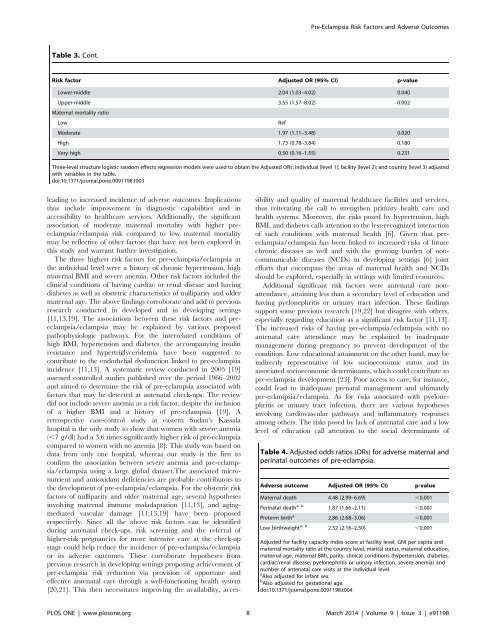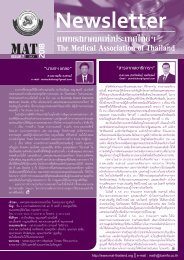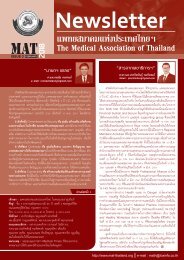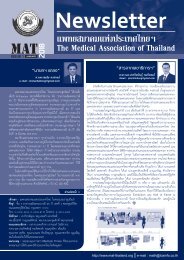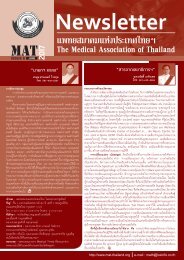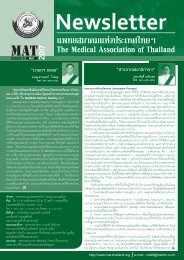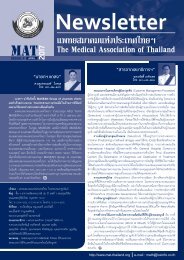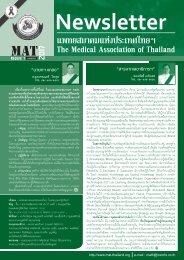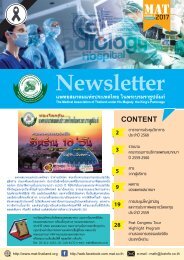risk factor for preeclampsia
Create successful ePaper yourself
Turn your PDF publications into a flip-book with our unique Google optimized e-Paper software.
Pre-Eclampsia Risk Factors and Adverse Outcomes<br />
Table 3. Cont.<br />
Risk <strong>factor</strong> Adjusted OR (95% CI) p-value<br />
Lower-middle 2.04 (1.03–4.02) 0.040<br />
Upper-middle 3.55 (1.57–8.02) 0.002<br />
Maternal mortality ratio<br />
Low<br />
Ref<br />
Moderate 1.97 (1.11–3.48) 0.020<br />
High 1.73 (0.78–3.84) 0.180<br />
Very high 0.50 (0.16–1.55) 0.231<br />
Three-level structure logistic random effects regression models were used to obtain the Adjusted ORs: individual (level 1); facility (level 2); and country (level 3) adjusted<br />
with variables in the table.<br />
doi:10.1371/journal.pone.0091198.t003<br />
leading to increased incidence of adverse outcomes. Implications<br />
thus include improvement in diagnostic capabilities and in<br />
accessibility to healthcare services. Additionally, the significant<br />
association of moderate maternal mortality with higher <strong>preeclampsia</strong>/eclampsia<br />
<strong>risk</strong> compared to low maternal mortality<br />
may be reflective of other <strong>factor</strong>s that have not been explored in<br />
this study and warrant further investigation.<br />
The three highest <strong>risk</strong> <strong>factor</strong>s <strong>for</strong> pre-eclampsia/eclampsia at<br />
the individual level were a history of chronic hypertension, high<br />
maternal BMI and severe anemia. Other <strong>risk</strong> <strong>factor</strong>s included the<br />
clinical conditions of having cardiac or renal disease and having<br />
diabetes as well as obstetric characteristics of nulliparity and older<br />
maternal age. The above findings corroborate and add to previous<br />
research conducted in developed and in developing settings<br />
[11,13,19]. The associations between these <strong>risk</strong> <strong>factor</strong>s and <strong>preeclampsia</strong>/eclampsia<br />
may be explained by various proposed<br />
pathophysiologic pathways. For the interrelated conditions of<br />
high BMI, hypertension and diabetes, the accompanying insulin<br />
resistance and hypertriglyceridemia have been suggested to<br />
contribute to the endothelial dysfunction linked to pre-eclampsia<br />
incidence [11,13]. A systematic review conducted in 2005 [19]<br />
assessed controlled studies published over the period 1966–2002<br />
and aimed to determine the <strong>risk</strong> of pre-eclampsia associated with<br />
<strong>factor</strong>s that may be detected at antenatal check-ups. The review<br />
did not include severe anemia as a <strong>risk</strong> <strong>factor</strong>, despite the inclusion<br />
of a higher BMI and a history of pre-eclampsia [19]. A<br />
retrospective case-control study at eastern Sudan’s Kassala<br />
hospital is the only study to show that women with severe anemia<br />
(,7 g/dl) had a 3.6 times significantly higher <strong>risk</strong> of pre-eclampsia<br />
compared to women with no anemia [8]. This study was based on<br />
data from only one hospital, whereas our study is the first to<br />
confirm the association between severe anemia and pre-eclampsia/eclampsia<br />
using a large global dataset.The associated micronutrient<br />
and antioxidant deficiencies are probable contributors to<br />
the development of pre-eclampsia/eclampsia. For the obstetric <strong>risk</strong><br />
<strong>factor</strong>s of nulliparity and older maternal age, several hypotheses<br />
involving maternal immune maladaptation [11,13], and agingmediated<br />
vascular damage [11,13,19] have been proposed<br />
respectively. Since all the above <strong>risk</strong> <strong>factor</strong>s can be identified<br />
during antenatal check-ups, <strong>risk</strong> screening and the referral of<br />
higher-<strong>risk</strong> pregnancies <strong>for</strong> more intensive care at the check-up<br />
stage could help reduce the incidence of pre-eclampsia/eclampsia<br />
or its adverse outcomes. These corroborate hypotheses from<br />
previous research in developing settings proposing achievement of<br />
pre-eclampsia <strong>risk</strong> reduction via provision of opportune and<br />
effective antenatal care through a well-functioning health system<br />
[20,21]. This then necessitates improving the availability, accessibility<br />
and quality of maternal healthcare facilities and services,<br />
thus reiterating the call to strengthen primary health care and<br />
health systems. Moreover, the <strong>risk</strong>s posed by hypertension, high<br />
BMI, and diabetes calls attention to the less-recognized interaction<br />
of such conditions with maternal health [6]. Given that <strong>preeclampsia</strong>/eclampsia<br />
has been linked to increased <strong>risk</strong>s of future<br />
chronic diseases as well and with the growing burden of noncommunicable<br />
diseases (NCDs) in developing settings [6] joint<br />
ef<strong>for</strong>ts that encompass the areas of maternal health and NCDs<br />
should be explored, especially in settings with limited resources.<br />
Additional significant <strong>risk</strong> <strong>factor</strong>s were antenatal care nonattendance,<br />
attaining less than a secondary level of education and<br />
having pyelonephritis or urinary tract infection. These findings<br />
support some previous research [19,22] but disagree with others,<br />
especially regarding education as a significant <strong>risk</strong> <strong>factor</strong> [11,13].<br />
The increased <strong>risk</strong>s of having pre-eclampsia/eclampsia with no<br />
antenatal care attendance may be explained by inadequate<br />
management during pregnancy to prevent development of the<br />
condition. Low educational attainment on the other hand, may be<br />
indirectly representative of low socioeconomic status and its<br />
associated socioeconomic determinants, which could contribute to<br />
pre-eclampsia development [23]. Poor access to care, <strong>for</strong> instance,<br />
could lead to inadequate prenatal management and ultimately<br />
pre-eclampsia/eclampsia. As <strong>for</strong> <strong>risk</strong>s associated with pyelonephritis<br />
or urinary tract infection, there are various hypotheses<br />
involving cardiovascular pathways and inflammatory responses<br />
among others. The <strong>risk</strong>s posed by lack of antenatal care and a low<br />
level of education call attention to the social determinants of<br />
Table 4. Adjusted odds ratios (ORs) <strong>for</strong> adverse maternal and<br />
perinatal outcomes of pre-eclampsia.<br />
Adverse outcome Adjusted OR (95% CI) p-value<br />
Maternal death 4.48 (2.99–6.69) ,0.001<br />
Perinatal death a, b 1.87 (1.66–2.11) ,0.001<br />
Preterm birth a 2.86 (2.68–3.06) ,0.001<br />
Low birthweight a, b 2.32 (2.16–2.50) ,0.001<br />
Adjusted <strong>for</strong> facility capacity index score at facility level, GNI per capita and<br />
maternal mortality ratio at the country level, marital status, maternal education,<br />
maternal age, maternal BMI, parity, clinical conditions (hypertension, diabetes,<br />
cardiac/renal disease, pyelonephritis or urinary infection, severe anemia) and<br />
number of antenatal care visits at the individual level.<br />
a Also adjusted <strong>for</strong> infant sex.<br />
b Also adjusted <strong>for</strong> gestational age.<br />
doi:10.1371/journal.pone.0091198.t004<br />
PLOS ONE | www.plosone.org 8 March 2014 | Volume 9 | Issue 3 | e91198


